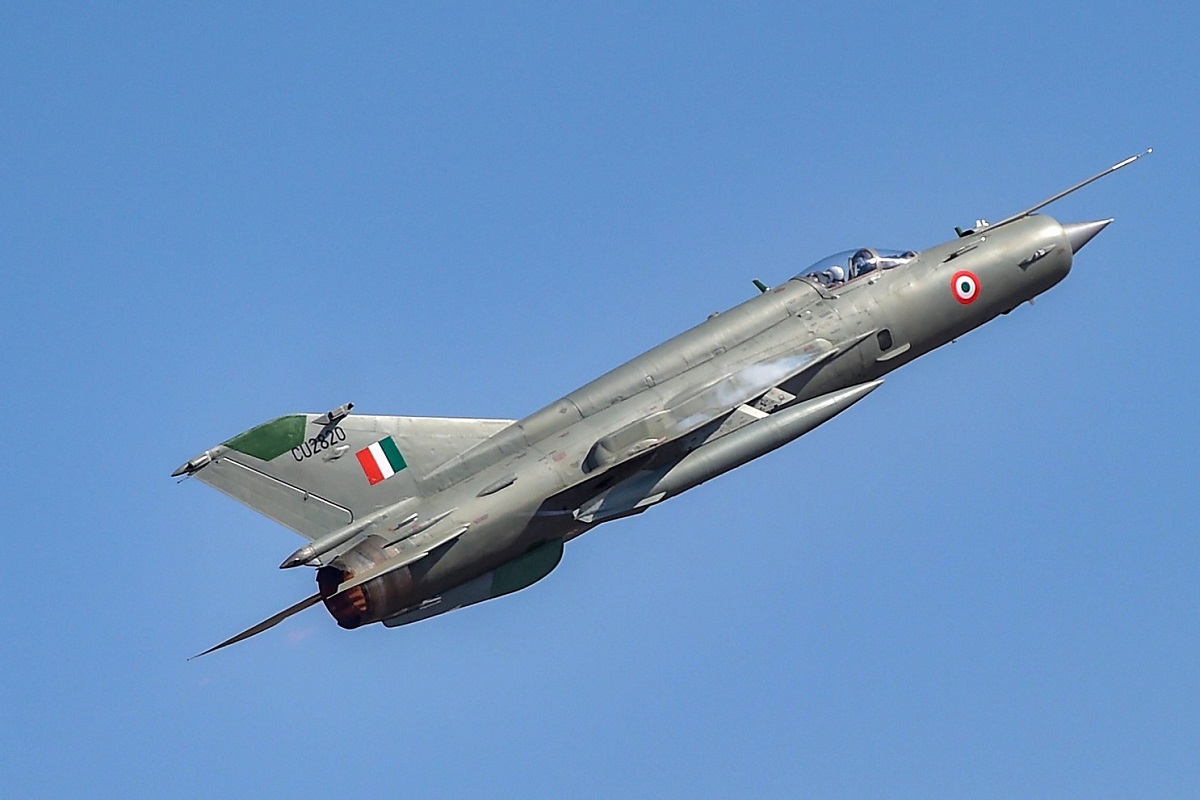In 2019, the Indian Air Force MiG-21s entered a dogfight with Pakistan’s F-16s and claimed to have brought down the ‘Fighting Falcon.’ It may have been no fluke. The aircraft, though old, still has some prowess that makes it a legend, and the US Air Force Pilots who came for the first edition of Cope India in 2004 got a taste of it.
The American F-15 Eagles faced off against Soviet-vintage Mig-21s of the Indian Air Force (IAF) and were trounced in 90 percent of the fights. The thrashing was so severe that the USAF decided to acquire more F-22 ‘Raptors’ for its fleet.
The military.com reporting about the exercise at the time said: “The whole world knows that if you mess with U.S. Air Force pilots, you’re going down. Hard. Except, someone forgot to send the memo to India. Because, in recent exercises, Indian flyboys in low-tech Russian and French jets defeated American F-15C pilots more than 90 percent of the time.”
American pilots have been quoted heaping praise on the Indian pilots. USAF Col. Greg Neubeck acknowledged that Indian pilots were “very proficient in [their] aircraft and smart on tactics. That combination was tough for us to overcome.
There have been various accounts from USAF pilots. But the EurAsian Times spoke to the then Commanding Officer of 3 Squadron ‘Cobras’ of the IAF for the first time to recount the first time the Bisons were pitted against the international force.
Presently, the unit is the last operational squadron of the MiG-21 ‘Bisons,’ which are planned to be retired in 2025. The fighter jet is often referred to as a lightweight Soviet ‘rocketship.’
Air Commodore Harish Nayani (Retired) was commanding the 3 Squadron of the IAF when it flew from Ambala air base to Gwalior a few days in advance to prepare for the fighter jet’s first wargame against the US Air Force.
Speaking to the EurAsian Times, Air Commodore Nayani said: “The Cope India 2004 was extremely educational and encouraging for us. We were surprised by the results. It was a lesson that an old machine can be fighting fit after upgrades.” The Bison is IAF’s most advanced MiG-21 variant.
The squadron arrived at Gwalior to load the PFM (pre-flight Message) software package on the EW suite. RWR (Radar Warning Receiver) and airborne self-protection Jammer, which only Bison could carry, were programmed to display and counter the F-15 radar signature.
“It was very exciting to see the F-15 – the best fighter in the world at the time. We had a combined mass briefing, and ground rules were laid down. Safety aspects were taken into consideration,” Nayani recalled the ‘Work Up’ phase.
The two air forces conducted the actual exercise in an Offensive Counter Air (OCA) versus Defensive Counter Air (DCA) setting. “We had the advantage of having AWACS IL-76 with us. We would alternate between OCA and DCA. What was surprising was that Bison, because of its small size, advanced EWS, and radar, could, in certain scenarios, get better than the F-15,” Nayani said.
Nayani could recall one of the incidents when he managed to get a kill over an F-15. “I remember an F-15 vectored onto us by radar. The F-15 is pretty large, and the Mig-21 is the smallest in the sky. And from a great distance, we can pick the F-15 coming in and we picked him visually about 20 km.” But the F-15 pilot was oblivious to the MiG-21 in front of him. “He was looking at radar and not looking visually. And he came so close to us. He was a pot-shot. We just have to point our nose and take a simulated launch,” the former 3 Squadron CO added.
“They (the USAF pilots) were both surprised and embarrassed. And they went back with a very valuable lesson – once bison is upgraded, it is equally lethal. Even if it is old, it is lethal.”

MiG-21s are the IAF’s first supersonic fighter jets and one of the force’s longest-serving aircraft. They will be phased out after 60 years of service, and the IAF is currently the only force in the world flying these vintage jets. The last MiG-21 Bis was produced in 1985.
MIG-21s were chosen to participate in the wargames because India’s latest machine, Su-30MKI, was operational, but it did not want to expose them to the USAF.
Bison’s prowess surprised the USAF pilots so much that they wanted to see its cockpit. “They (USAF pilots) wanted to see the MIG-21 cockpit, and they were surprised. Old bison was mostly all dials and needles. Bison had a new HUD and multifunction display within its single windshield bubble canopy,” recalled Nayani.
MiG-21’s, such as low radar visibility, instantaneous turn rate, and “jackrabbit acceleration,” were critical factors at Cope India. Plus, its new helmet-mounted sight and high-off-boresight R-73 air-to-air missiles turned the MiG-21 into a “Great Equaliser” in the WVR (within visual range) combat scenario.
The Russians could not help but quip at the turn of events. “With the benefit of hindsight, it’s good the Americans discovered their shortcomings in peace rather than war. Had the pilots of the 3rdWing come up against the might of Russian air power during the Cold War, they probably wouldn’t have winged it back to Alaska,” a report in Russia Beyond said.
MiG-21 – The Legacy Fighter Jet
The MiG-21 is probably one of the best-known Soviet aircraft. It is the most-produced supersonic jet in aviation history. It was designed in response to the Korean War’s need for a short-range interceptor and light strike fighter.

First flown in 1955, the MiG-21 was the first Soviet plane to reach Mach 2. For three decades, variants of the MiG-21 went head-to-head with the F-4 Phantom and other American-made fighters in Cold War-related conflicts worldwide.
Approximately 60 countries across four continents have flown the MiG-21, and it still serves many nations six decades after its maiden flight.
“The MiG-21 is like a rocket with small wings to keep it in the air. It was designed to shoot down airplanes like the U-2 spy planes. Its dynamic thrust goes up to 9,900 kg; it can practically accelerate in a vertical climb. In seconds, it reaches its business altitude,” Group Captain MJ Vinod told the EurAsian Times. He was in 4 Squadron of the IAF between 1992-1997.
The MiG-21 was a supersonic monster that flew faster than twice the speed of sound at Mach 2.25. It was powered by a vast Tumansky R-11 F-300 engine. Its nose cone contained an R1L radar that could locate enemy fighters at a range of 20 km.
India got its first single-engine MiG-21 in 1963, and it progressively inducted 874 variants of the Soviet-origin supersonic fighters to bolster its combat potential. The aircraft has seen action in different wars, including the 1971 Bangladesh war, the 1999 Kargil conflict, and the most recent air duel after the Balakot airstrike in 2019.
An American US Air Force’s Constant Peg program pilot has described the ‘Fishbed’ (the NATO name for MiG-21) as a “beefed up, fighter version” of the Northrop T-38 Talon jet trainer. The MiG was fast, simple, and “surprisingly nimble” in simulated dogfights against American pilots in American planes. Although MiG-21s had numerous shortcomings, the Soviets still produced 11,000 of them, prompting McCoy to call the planes “deadly due to sheer numbers.”
MiG-21- No ‘Flying Coffin’
Air Commodore Nayani takes umbrage to the monikers given to the fighter jet. “Media has coined these phrases (Widowmaker and Flying Coffin). These are derogatory. I have been flying that aircraft for a long time.”
The aircraft suffered a series of crashes over the years, flagging safety concerns.
The aircraft’s speed was both its biggest advantage and disadvantage. In the absence of adequate trainers, the IAF pilot trainees immediately graduated from propeller-driven HPT-32 to jet-powered HJT-16 Kiran. Then, they would graduate to MiG-21s, and the first thing that hit them was the speed of the Russian fighter jet.
“It was designed as a supersonic high-altitude interceptor. Its drawback was high landing speed. It was never intended to be a lead trainer of young trainees. Now, Hawk has plugged the gap,” opined Nayani.
Describing its speed, Group Captain Vinod said: “Indian MiG-21 has an emergency power reserve (EPR), the second reheat. With EPR, she accelerates much faster. I remember doing a DACT (dissimilar air combat training) with one other fighter (I wouldn’t like to name), and being a superior fighter, he was supposed to demonstrate his acceleration to me; little did he know that at the end of the acceleration run, I matched him. Thanks to the second reheat.”
- Ritu Sharma has been a journalist for over a decade, writing on defense, foreign affairs, and nuclear technology.
- The author can be reached at ritu.sharma (at) mail.com
- Follow EurAsian Times on Google News




